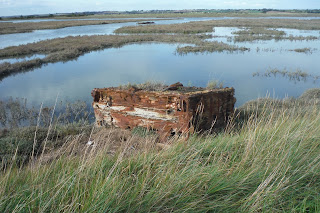Saturday 23rd September Wallasea
Wallasea sits within the waters of the rivers Crouch and
Roach, Paglesham Pool and Creek, not far from Rochford in Essex. (Follow the
brown signs) We drove to the Essex Marina at Wallasea and parked there.
We had
a hearty sandwich and jacket potato in this friendly boat club bar that
welcomes anyone. They said we could leave the car while we explored the island
though to me Wallasea seemed just part of the mainland causing Bob and I to
argue about its status. Only when we cycled back the way we came in the car, could
I see that the road is elevated as it breaches the sea wall and at some tides
the route could be slightly under water in places. I conceded!
In 2006 115 hectares of farmland was flooded to create
mudflats, salt marsh. Lagoons and islands were formed for the purpose of providing winter ground for
wading birds. The RSPB transported 4.5 million tons of earth utilising
Crossrail’s tunnel excavation material.
We thought we would be able to cycle round the island but
although the RSPB Wallasea website mentions cycling we couldn’t see where.
There is a fantastic cycle shed with natural roof, grasses, wild flowers. Its
walls become flying insect hotels and lower down, the ground crawlers have their
own natural material habitation. We left the bike and did one of the walks.
Everything is in its infancy at the present and there are signs of construction
everywhere. I read that RSPB expect to finish the project in 2025. When nature
has properly taken over I am sure it will be lovely but the time of year wasn’t
conducive to seeing much.
We followed the 4.5 kilometre trail which seemed to go on
endlessly. We only saw small butterflies like the one called the small blue,
delicate and tiny. We were intrigued by the long, thin, shiny black beetle we
hadn’t seen anywhere before. Apparently it is an oil beetle of which there are
4 kinds left in Britain. They are becoming a rare species. Growing up to 3 cms
they get their name from the toxic oily substance released from their leg
joints to deter predators. When the larvae hatch they hop onto a passing mining
bee and once reaching the nest they feed and live off bee eggs, nectar and
pollen. To find them in a habitat means that there must be wild bees around
which in turn indicates the health of a wild life area!
Tiny birds darted across our path and earlier I thought I saw
a marsh harrier.
Every now and again a loud horn sounded. It looked like
boats were racing, the sails just visible over the sea wall. We didn’t see many
people but it looked like dog walkers could walk the seawall only which is
probably good for the wildfowl…when they come.
When we rode back to the seawall at the road we looked
closely at the box like structures rotting in the Saltings and decided they
must be remnants of old pontoons. Like castle ruins they add a bit of character
to the landscape.
Back at the marina we used the toilets which are pristine mostly
because you need a touch code to get in. I’ve never seen this before but what a
good idea. A cuppa and fudge cake went down a treat and we left for home after
telling an interested boat lady about our blog. We thought we might meet in France
when we attempt cycling canals in France after our 100 island challenge. We
have now completed 80 with 1 year to go.





No comments:
Post a Comment